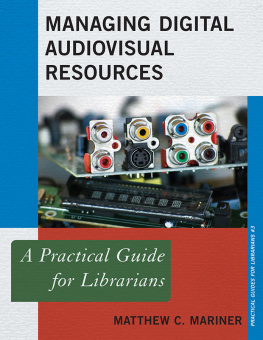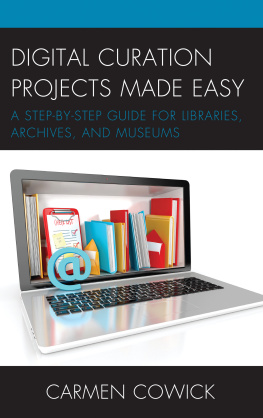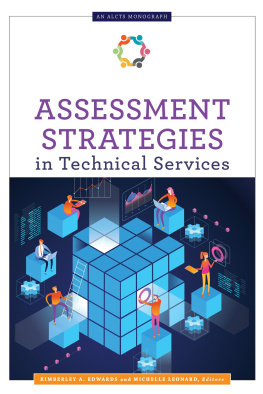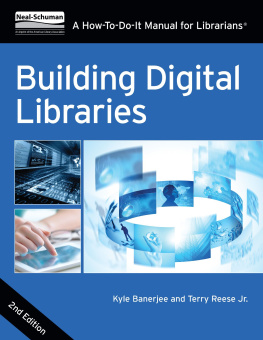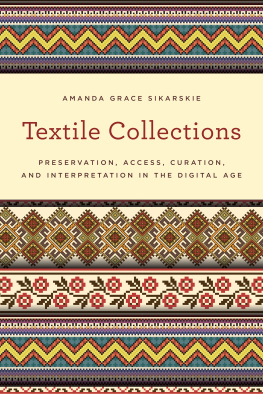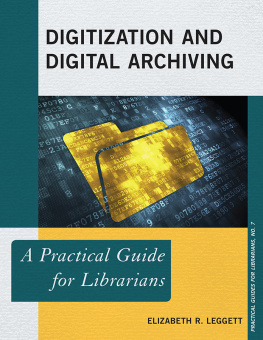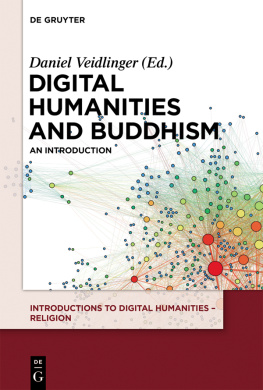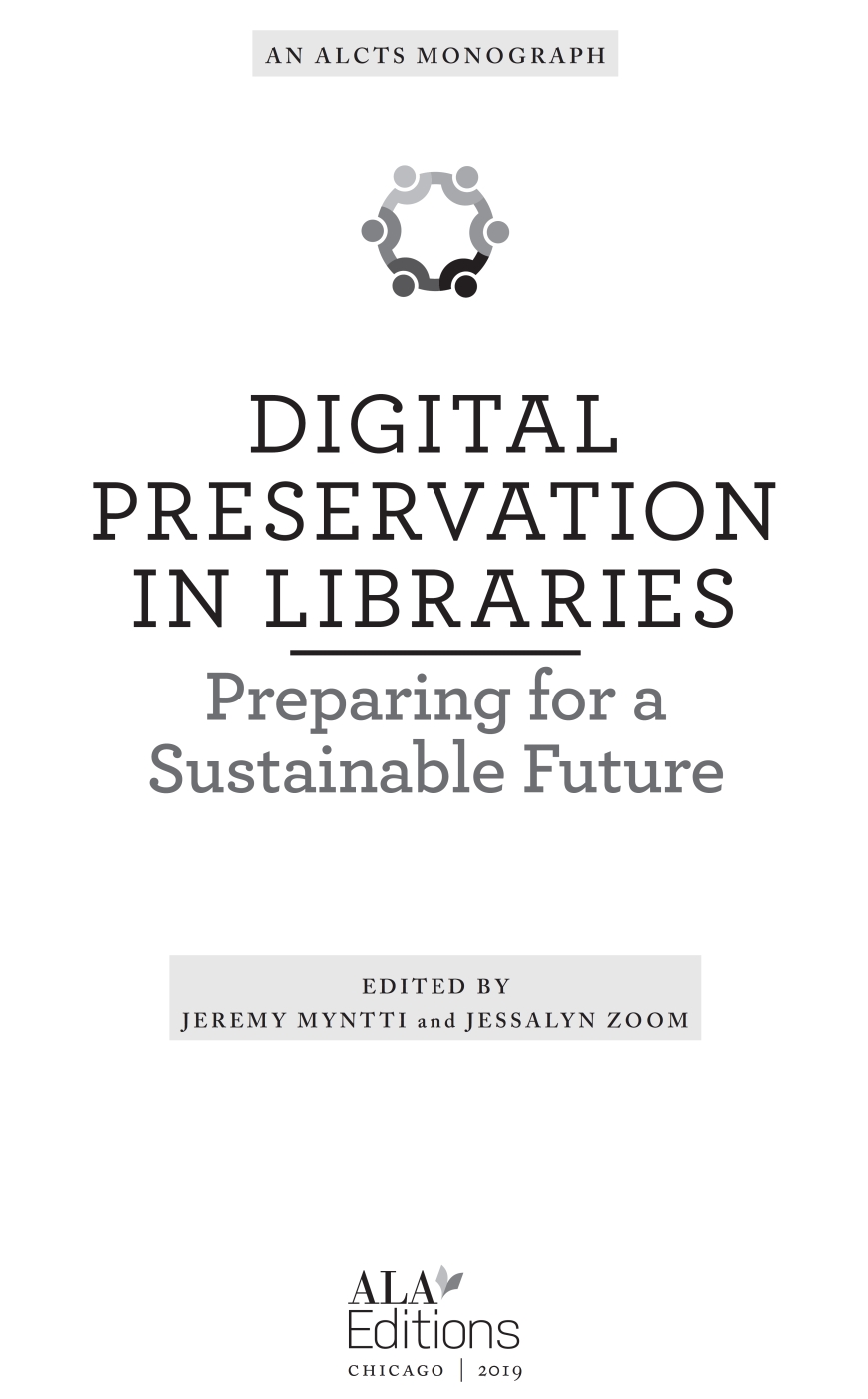
ALA Editions purchases fund advocacy, awareness, and accreditation programs for library professionals worldwide.
JEREMY MYNTTI is head of digital library services at the University of Utahs J. Willard Marriott Library. This position allows him the opportunity to supervise faculty and staff who are converting content from analog to digital, creating and maintaining the metadata for digital collections, and preserving the librarys digital assets. He also works closely with developers to create the systems and tools necessary for making the librarys digital assets available. Prior to this position, he was head of cataloging and metadata services and the ILS administrator for the University of Utah Libraries. He received his MLIS degree from the University of Alabama and has undergraduate degrees in music and business management from Utah Valley University.
JESSALYN ZOOM is head of the History and Military Science Section in the Acquisition and Bibliographic Access Directorate at the Library of Congress. She was formerly acting BIBCO program coordinator for the Program for Cooperative Cataloging (PCC), a consortium that influences metadata best practices and provides training to members worldwide. Through her work in the PCC, she developed cataloging expertise and served as a trainer. Zoom holds an MLS degree as well as an MA in Asian studies, both from the University of Iowa. Her areas of interest are in workflow efficiency and competency in technical services.
2019 by the American Library Association
Extensive effort has gone into ensuring the reliability of the information in this book; however, the publisher makes no warranty, express or implied, with respect to the material contained herein.
ISBNs
978-0-8389-1713-8 (paper)
978-0-8389-1745-9 (PDF)
978-0-8389-1744-2 (ePub)
978-0-8389-1746-6 (Kindle)
Library of Congress Cataloging-in-Publication Data
Names: Myntti, Jeremy, editor. | Zoom, Jessalyn, editor.
Title: Digital preservation in libraries : preparing for a sustainable future / edited by Jeremy Myntti and Jessalyn Zoom.
Description: Chicago : ALA Editions, an imprint of the American Library Association, 2019. | Series: An ALCTS monograph | Includes bibliographical references and index.
Identifiers: LCCN 2018008474 | ISBN 9780838917138 (print) | ISBN 9780838917442 (epub) | ISBN 9780838917459 (pdf) | ISBN 9780838917466 (Kindle)
Subjects: LCSH: Digital preservation.
Classification: LCC Z701.3.C65 D535 2018 | DDC 025.8/4dc23 LC record available at https://lccn.loc.gov/2018008474
Cover image Adobe Stock.
CONTENTS
Jeremy Myntti and Jessalyn Zoom
Erin Baucom
Ross Spencer
Christine Madsen and Megan Hurst
Rosy Jan
Camilla Tubbs and Angela Fang Wang
Angela Fritz
Somaya Langley
Ashley Jones and Eric Johnson
Tawnya Mosier Keller and Jeremy Myntti
Leigh Rosin
Grant Hurley
Amanda May
Aaron Trehub, Corey Davis, Mark Jordan, Cinda May, and Sam Meister
Edith Halvarsson, Sarah Mason, Lee Pretlove, David Gerrard, Somaya Langley, and James Mooney
R. F. (Chip) German and Kara M. McClurken
Moriah Neils Caruso, Simon ORiordan, Erin Wolfe, Liz Woolcott, Jennifer Mullins, and Drew Krewer
Sara R. Benson
Carla S. Myers
Jeremy Myntti and Jessalyn Zoom
L ibraries, archives, and museums have been preserving intellectual content for many centuries. For physical materials, there are tried-and-true methods of preservation that are widely practiced throughout the world. With the digital age, new methods of preservation have been explored to ensure that digital content is preserved for generations to come. According to the Digital Preservation Coalition, digital preservation refers to the series of managed activities necessary to ensure continued access to digital materials for as long as necessary.
There are many terms associated with digital preservation (e.g., appraisal, integrity, fixity, renderability, format obsolescence, migration, replication, emulation, encapsulation) and many more acronyms (e.g., PREMIS, OAIS, DPN, DPC, TDR, TRAC). The goal of this book is to provide useful insights into why digital preservation in libraries is so important and to help readers understand the importance of key concepts in this field. Many libraries have been practicing digital preservation methods for several years, and we hope that the insight acquired by those who have invested resources in digital preservation will help others who need to engage in these activities in the future.
As you will discover from several chapters in this book, the digital preservation field has evolved rapidly over the past several years. The projects, tools, and strategies for digital preservation that are presented in this book are current as of the publication date, but they will most likely change over time as new methods and technologies emerge to improve the processes for preserving digital content.
This book is divided into six parts with eighteen chapters. The Erin Baucom discusses many of the major efforts that have already taken place in digital preservation, including standards creation through collaborative efforts. This chapter provides an overview of how the digital preservation landscape has changed since the mid-1990s, when libraries first began seriously thinking about digital preservation.
looks at digital preservation tasks at a higher level in order to formulate questions about the tasks and challenges faced when preserving digital objects. Ross Spencer provides details about many of the technical concepts around digital preservation, and answers questions on what these concepts are and why specific tasks are completed.
The Christine Madsen and Megan Hurst provide a high-level overview for creating a digital preservation policy, taking into account the goals and mission of the institution.
In Rosy Jan provides information about different preservation strategies such as migration, emulation, encapsulation, and technology preservation.
In Camilla Tubbs and Angela Fang Wang share their unique experience of creating a comprehensive set of digital preservation policies, which consist of a collection development policy, an institutional repository policy, and a digital preservation policy.
In Angela Fritz discusses the questions that should be asked when reviewing a digital preservation system to make sure that the right system is chosen to fit the institutions needs.
In Somaya Langley provides details about developing the Digital Stewardship End-to-End Workflow Model. This model is then demonstrated in a use case for the preservation of born-digital objects.
The by Ashley Jones and Eric Johnson, is a case study for the digital preservation program at the Miami University Libraries, and describes the process of reviewing different digital preservation systems and the implementation of the chosen solution.
by Tawnya Mosier Keller and Jeremy Myntti, is a case study from the University of Utah. The authors share their firsthand experience about implementing a digital preservation system and developing new software to automate the ingestion of content into this system. This chapter also provides information to help archivists determine what collections should be the top priority for digital preservation.
The Leigh Rosin looks at digital preservation principles and assumptions, and how they apply to preserving a digital photograph collection, which the author considers to be a straightforward example without a lot of issues. The assumptions made at the beginning of the preservation project were tested in the course of the project.
Next page


